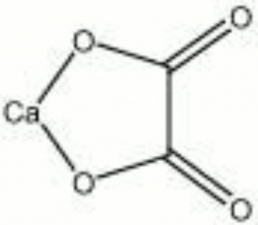Whewellite
Description
A white to colorless mineral composed of calcium oxalate monohydrate. Whewellite is formed on the surface of marble and limestone due to the presence of microorganisms, such as lichen.
Synonyms and Related Terms
calcium oxalate monohydrate; calcium salt of ethanedioic acid; wewelita (Esp.); whewelite (Port.); Whewellit (Deut.)
Other Properties
Soluble in dilute mineral acids. Insoluble in water, acetic acid. Slightly hygroscopic.
Transparent to translucent tabular crystals with good cleavage in all three planes.
Luster=vitreous to pearly. Streak = white. Fluorescent in UV light.
| Composition | Ca(C2O4)-H2O |
|---|---|
| CAS | 5794-28-5 |
| Mohs Hardness | 2.5-3.0 |
| Density | 2.2 |
| Molecular Weight | mol. wt. = 146.11 |
Hazards and Safety
Fisher Scientific: MSDS
Additional Information
° Mineralogy Database: Whewellite° M. del Monte, C. Sabbioni, G.Zappia. The origin of calcium oxalates on historical buildings, monuments and natural outcrops. The science of the total environment 67, (1987), pp. 17-39 ° B. Ford, I.MacLeod, P.Haydock, "Rock art pigments from Kimberley region of Western Australia: identification of the minerals and conversion mechanisms." Studies in conservation 39, no. 1 (1994), pp. 57-69
Sources Checked for Data in Record
- Random House, Webster's Encyclopedic Unabridged Dictionary of the English Language, Grammercy Book, New York, 1997
- External source or communication Comment: B. Ford, I.MacLeodand P.Haydock, "Rock art pigments from Kimberley region of Western Australia: identification of the minerals and conversion mechanisms." Studies in conservation 39, no. 1 (1994), pp. 57-69
- Wikipedia, the free encyclopedia, at http://www.wikipedia.com Comment: http://en.wikipedia.org/wiki/Whewellite (Accessed Nov. 29, 2005)
